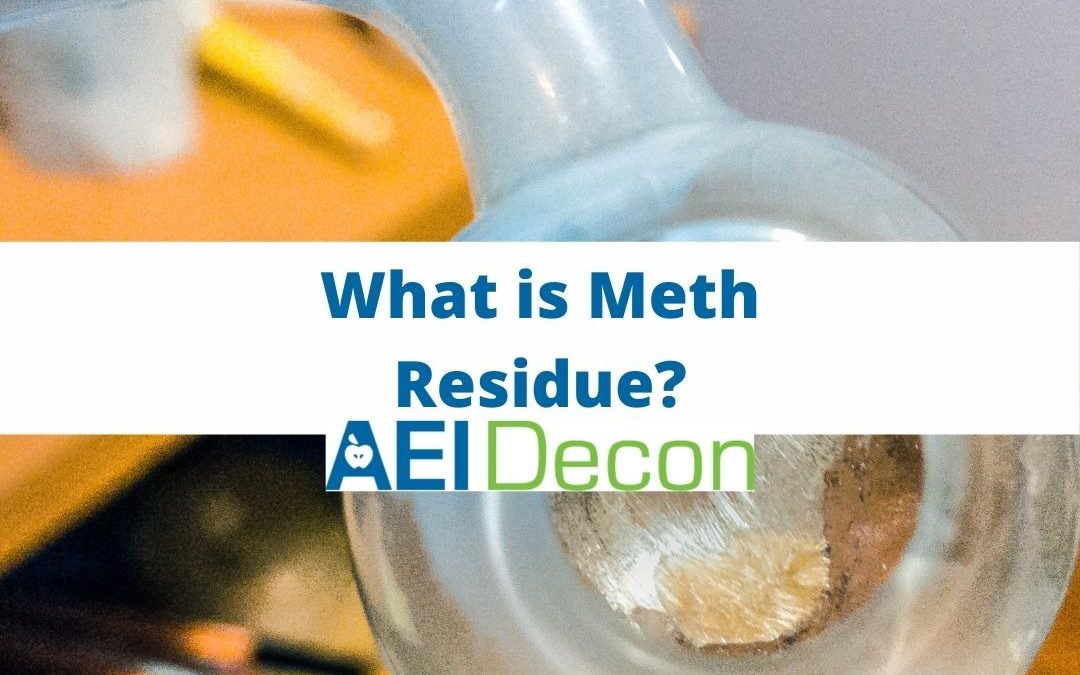Methamphetamine is a highly addictive stimulant that affects the central nervous system. It creates intense feelings of euphoria and is associated with many health risks. Some of these are addiction, heart and brain damage, seizures, and more. But what about meth residue? What is it, and does it really pose any risk to your home or health?
What is Meth Residue?
Meth is a very interesting and unstable molecule. It changes states easily and has a long half-life (or rate of decay.) When meth oxidizes and changes into a vapor, via cooking or smoking, it absorbs into the structures and settles onto the surfaces of your home. This ‘residue’ is all but indistinguishable to your senses. In fact, many do not even realize there’s a problem until they’re already ill.
There is little debate that the contamination from cooking meth is toxic. And, given the myriad of harmful chemicals used in that process, decontaminating former meth labs is an intuitive step. The problem lies in identifying such locations. And with modern inventions of the shake-and-bake method and mobile meth labs, that is more difficult than ever before.
That is why proper testing is such a critical part of buying or selling a home. It may also be important when renting a house or apartment, renovating, or when dealing with auctioned or stolen vehicles.
But what about smoking? Is that really enough to leave behind problematic levels of residue? The short answer is yes – sort of. But, to unpack that, we must consider the science.
Is Smoking Meth Once Enough to Contaminate a Home?
According to the available research, when an individual smokes, roughly 33% of their dose is left behind in the environment. Of course, 33% may not seem like much, since we’re talking about relatively small quantities of a drug inside entire rooms and buildings. But let’s take a harder look at this figure.
In 2008, Martyny et. al published a study on simulated smoking. They found that the average rates of residual meth, after inhalation, fall between 0.02 to 0.07μg/100cm2. To clarify, that’s a single ‘smoke’ in a laboratory environment, which will include controlled doses. Multiple ‘smokes,’ however, fell somewhere between 1.54 and 5.10μg/100cm2.
Now, applying this research to the real world requires us to make some necessary considerations. First, very few users will take a single hit and be done for the day. Indeed, if someone is going to smoke, it’s probably going to happen more than once. And they won’t be utilizing the same dose as in a lab, either, so the amount of meth is going to vary widely. That, and the size of the area smoked, ventilation, and the person’s individual inhale and burn off can create ‘outliers’ (or numbers that are much larger or smaller than the average.)
So, what can we conclude from all that data? For starters, we can conclude that meth residue absolutely stays in a home after smoking. And, in certain circumstances, this is even enough to contaminate a home or business.
Does That Make Meth Residue Dangerous?
In a previous blog we discussed that the lowest observable adverse effects of meth take place at 0.75 mg/kg per day. That informs Utah’s decontamination limit of 1.0 µg/100cm². (That’s just below the daily reference dose for infants.) However, we must acknowledge that these figures are estimates and/or based in animal research. You see, due to ethical ramifications and safety concerns, there is very little direct research exposing humans (intentionally) to residual meth. That makes it impossible to confirm, without question, that it is the meth residue (specifically) that makes people ill in meth-contaminated homes. However, it equally impossible to confirm it is not.
That being said, there are a few things we do know. For instance, we know that there are many examples of individuals finding themselves severely ill after moving, later discovering the property is contaminated. We also know that children can test positive for meth due to environmental exposure.
Similarly, we know meth residual meth can enter your body through dermal contact, exposing you by simply touching contaminated surfaces. If in an aerosol form due to off-gassing or certain renovations, it is possible for meth to enter your system through inhaling leftover fumes as well. It can also enter your system through digestion, which primarily occurs through hand-to-mouth contact after touching contaminated surfaces.
Common sense also invites certain conclusions. For instance, given the toxicity of the chemicals used to make meth, we can infer that long-term exposure is indeed going to take a toll on a person’s overall health. We can also infer that the presence of meth is likely a signal that other chemical residues may remain as well.
So, in this way, our original answer becomes clear. Yes, meth residue is very likely dangerous. It is merely the how and why that science has yet to uncover.
What is My Next Step for Dealing With Meth Residue?
By Utah law, meth contamination requires proper clean-up. That’s not simply wiping things down, either, since regular detergents and cleaning methods are more likely to spread meth around rather than remove it. That is why the state of Utah has specific regulations regarding testing and decontamination. This is also why AEI Decon relies on specific protocols and high-quality meth removal formulas.
For all these reasons, if you have reason to believe there is meth in your property, or you are buying or selling a building or purchasing a used vehicle – we strongly recommend having a licensed professional conduct a test. And if you’re in Utah, AEI Decon is happy to help with all your testing and decontamination needs. Give us a call for your free quote at (801) 888-6698.

